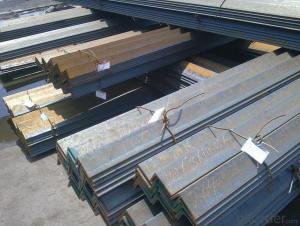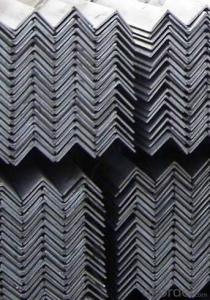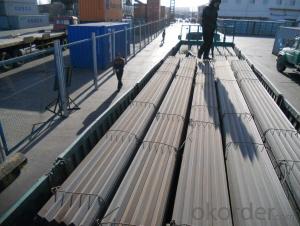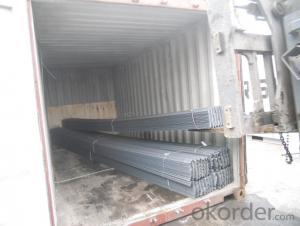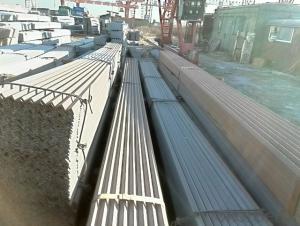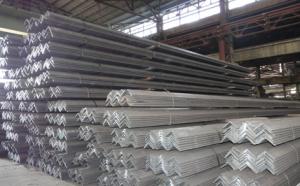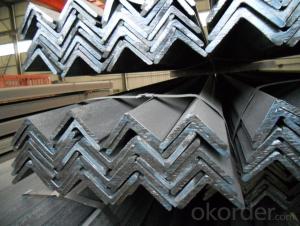Supply Hot Rolled Angle Steel for Transmission Towers
- Loading Port:
- Tianjin
- Payment Terms:
- TT OR LC
- Min Order Qty:
- 25 m.t.
- Supply Capability:
- 20000 m.t./month
OKorder Service Pledge
OKorder Financial Service
You Might Also Like
Specification
OKorder is offering high quality Hot Rolled Steel Angle at great prices with worldwide shipping. Our supplier is a world-class manufacturer of steel, with our products utilized the world over. OKorder annually supplies products to European, North American and Asian markets. We provide quotations within 24 hours of receiving an inquiry and guarantee competitive prices.
Product Applications:
Hot Rolled Steel Angles are ideal for structural applications and are widely used in the construction of buildings and bridges, and the manufacturing, petrochemical, and transportation industries.
Product Advantages:
OKorder's Steel Angles are durable, strong, and resist corrosion.
Main Product Features:
· Premium quality
· Prompt delivery & seaworthy packing (30 days after receiving deposit)
· Corrosion resistance
· Can be recycled and reused
· Mill test certification
· Professional Service
· Competitive pricing
Product Specifications:
Manufacture: Hot rolled
Grade: Q195 – 235
Certificates: ISO, SGS, BV, CIQ
Length: 6m – 12m, as per customer request
Packaging: Export packing, nude packing, bundled
Sizes: 25mm-250mm | ||
a*t | ||
25*2.5-4.0 | 70*6.0-9.0 | 130*9.0-15 |
30*2.5-6.6 | 75*6.0-9.0 | 140*10-14 |
36*3.0-5.0 | 80*5.0-10 | 150*10-20 |
38*2.3-6.0 | 90*7.0-10 | 160*10-16 |
40*3.0-5.0 | 100*6.0-12 | 175*12-15 |
45*4.0-6.0 | 110*8.0-10 | 180*12-18 |
50*4.0-6.0 | 120*6.0-15 | 200*14-25 |
60*4.0-8.0 | 125*8.0-14 | 250*25 |
FAQ:
Q1: Why buy Materials & Equipment from OKorder.com?
A1: All products offered byOKorder.com are carefully selected from China's most reliable manufacturing enterprises. Through its ISO certifications, OKorder.com adheres to the highest standards and a commitment to supply chain safety and customer satisfaction.
Q2: How do we guarantee the quality of our products?
A2: We have established an advanced quality management system which conducts strict quality tests at every step, from raw materials to the final product. At the same time, we provide extensive follow-up service assurances as required.
Q3: How soon can we receive the product after purchase?
A3: Within three days of placing an order, we will begin production. The specific shipping date is dependent upon international and government factors, but is typically 7 to 10 workdays.
Alloy No | Grade | Element (%) | ||||
C | Mn | S | P | Si | ||
Q235 | B | 0.12—0.20 | 0.3—0.7 | ≤0.045 | ≤0.045 | ≤0.3 |
Alloy No | Grade | Yielding strength point( Mpa) | ||||
Thickness (mm) | ||||||
≤16 | >16--40 | >40--60 | >60--100 | |||
≥ | ||||||
Q235 | B | 235 | 225 | 215 | 205 | |
Alloy No | Grade | Tensile strength (Mpa) | Elongation after fracture (%) | |||
Thickness (mm) | ||||||
≤16 | >16--40 | >40--60 | >60--100 | |||
≥ | ||||||
Q235 | B | 375--500 | 26 | 25 | 24 | 23 |
Images:

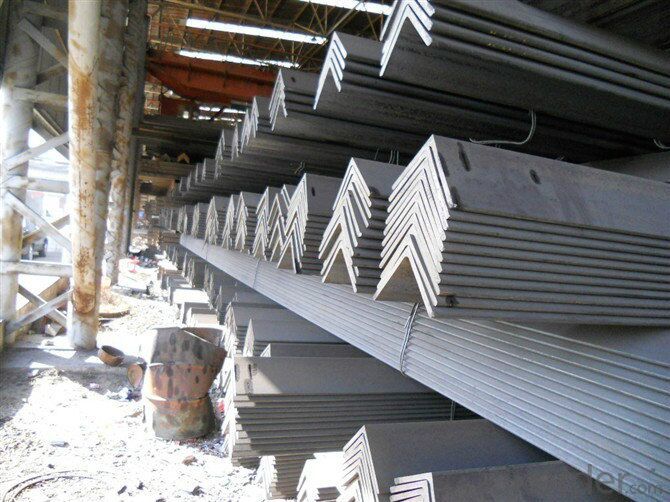
- Q: Are steel angles magnetic?
- Steel angles possess magnetic properties as they are made of steel, a ferromagnetic material. Ferromagnetic materials, like steel, can be magnetized and are drawn towards magnets. Due to the composition of steel, which includes iron and other elements, it exhibits a magnetic response. This characteristic finds practical applications in diverse fields, including construction, where steel angles are frequently employed to provide structural support.
- Q: What are the standard dimensions of steel angles?
- The dimensions of steel angles vary depending on the specific type, whether it is equal or unequal. Typically, equal steel angles have legs of equal length, while unequal steel angles have legs of different lengths. For equal steel angles, the standard dimensions can range from 20mm x 20mm x 3mm to 200mm x 200mm x 24mm. These measurements represent the length of each leg and the thickness of the angle. On the other hand, unequal steel angles have varying dimensions. The standard measurements for unequal steel angles range from 40mm x 25mm x 4mm to 200mm x 150mm x 12mm. Again, these measurements indicate the length of each leg and the thickness of the angle. It is important to note that these dimensions are considered standard, and it is possible to manufacture custom sizes based on specific requirements. Furthermore, slight variations in these measurements may occur due to different steel standards and regional practices.
- Q: What are the different corrosion protection methods for steel angles?
- There are several corrosion protection methods for steel angles, including galvanization, powder coating, paint coating, and epoxy coating.
- Q: How can steel angles be protected against corrosion?
- Steel angles can be protected against corrosion through various methods such as applying protective coatings like paint or galvanization, using corrosion inhibitors, implementing cathodic protection systems, or selecting stainless steel angles which are inherently resistant to corrosion.
- Q: Can steel angles be galvanized or coated for additional protection?
- Yes, steel angles can be galvanized or coated for additional protection. Galvanizing or coating provides a protective layer that helps prevent corrosion and extends the lifespan of the steel angle.
- Q: Are there any specific design considerations when using steel angles?
- There are several important factors to consider when using steel angles in design. Firstly, it is crucial to assess the load-bearing capacity of the steel angles. These angles are often used in structural applications where they must bear heavy loads. Therefore, it is vital to determine the required strength and stiffness of the angles based on the anticipated loads and design requirements. Secondly, it is necessary to carefully design the connections between the steel angles and other structural elements. These connections must be strong and secure. Various methods, such as bolting, welding, or using additional plates or brackets, can be employed to ensure the stability and integrity of the connections. In addition, the stability of the steel angles themselves must be taken into account. Long and slender steel angles can be susceptible to lateral-torsional buckling when subjected to bending loads. Therefore, appropriate measures, such as bracing or increasing the section modulus, should be implemented to enhance the angles' stability. Furthermore, steel angles may be prone to corrosion, particularly in outdoor or corrosive environments. To prevent or minimize corrosion, adequate protective coatings or treatments should be applied. This will ensure the long-term durability and performance of the angles. Lastly, when using steel angles in architectural or design applications, aesthetic considerations may also be important. The appearance of the angles, including the surface finish or color, should be taken into account to achieve the desired visual effect. To summarize, the load-bearing capacity, connection details, stability, corrosion protection, and aesthetic aspects are all crucial design considerations when working with steel angles. These factors are essential for ensuring the structural integrity, durability, and overall performance of steel angle applications.
- Q: How do steel angles perform under extreme temperatures?
- Steel angles generally perform well under extreme temperatures. Steel is known for its high strength and durability, and it retains these properties even in extreme heat or cold. However, at extremely high temperatures, steel may experience some loss of strength due to softening or even melting. Moreover, rapid cooling after exposure to high temperatures can cause thermal stress and possibly lead to cracking or distortion. Therefore, it is crucial to consider the specific temperature range and duration when assessing the performance of steel angles under extreme temperatures.
- Q: Can steel angles be used for bracing?
- Yes, steel angles can be used for bracing. Steel angles are commonly used in construction and engineering projects to provide structural support and reinforcement. They are versatile and can be easily welded or bolted into place, making them suitable for various applications, including bracing. Steel angles are typically strong and rigid, which makes them effective in providing stability and resisting lateral forces. They are often used to brace columns, beams, and other structural elements, enhancing the overall strength and stability of the structure.
- Q: How do steel angles perform under high temperatures?
- Steel angles perform well under high temperatures as they have a high melting point and exhibit good thermal conductivity. They retain their strength and structural integrity, making them suitable for use in various applications such as construction, manufacturing, and industrial processes that involve elevated temperatures.
- Q: How are steel angles protected against abrasion?
- Steel angles are commonly used in construction and industrial applications, where they are subject to various forms of abrasion. To protect steel angles against abrasion, several methods are employed. One common method is the application of protective coatings. These coatings can be in the form of paints, epoxy coatings, or other specialized coatings designed for abrasion resistance. The coatings act as a barrier between the steel surface and the abrasive elements, preventing direct contact and reducing the wear and tear caused by friction. Another method is the use of rubber or plastic linings. These linings are typically applied to the surfaces of the steel angles that are most prone to abrasion. The rubber or plastic material absorbs the impact of abrasive forces, cushioning the steel and reducing the wear rate. Additionally, these linings provide an extra layer of protection against corrosion and chemical attacks. In some cases, steel angles may undergo a process called hardening or heat treatment. This involves subjecting the steel to high temperatures and then rapidly cooling it. This process alters the microstructure of the steel, making it harder and more resistant to abrasion. Heat-treated steel angles are commonly used in high-wear environments such as mining and material handling industries. Furthermore, engineers may opt to design steel angles with specific profiles or shapes that offer better resistance to abrasion. These profiles can include rounded edges, chamfers, or other features that minimize direct contact with abrasive materials. Overall, the protection against abrasion for steel angles involves a combination of protective coatings, linings, heat treatment, and thoughtful design. By implementing these measures, the lifespan and performance of steel angles can be significantly prolonged, reducing maintenance costs and ensuring their durability in abrasive environments.
Send your message to us
Supply Hot Rolled Angle Steel for Transmission Towers
- Loading Port:
- Tianjin
- Payment Terms:
- TT OR LC
- Min Order Qty:
- 25 m.t.
- Supply Capability:
- 20000 m.t./month
OKorder Service Pledge
OKorder Financial Service
Similar products
Hot products
Hot Searches
Related keywords
